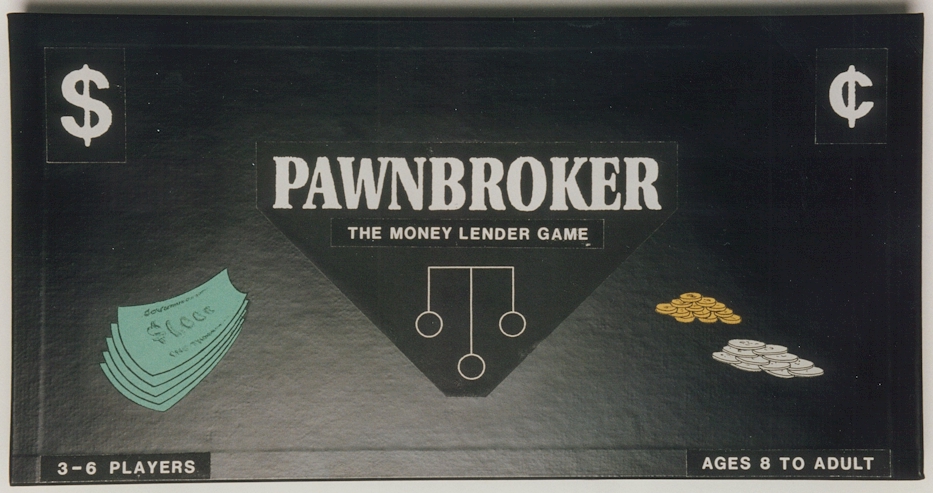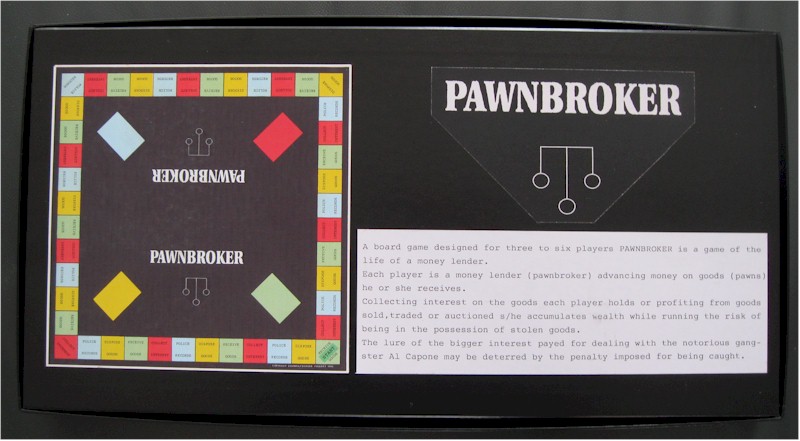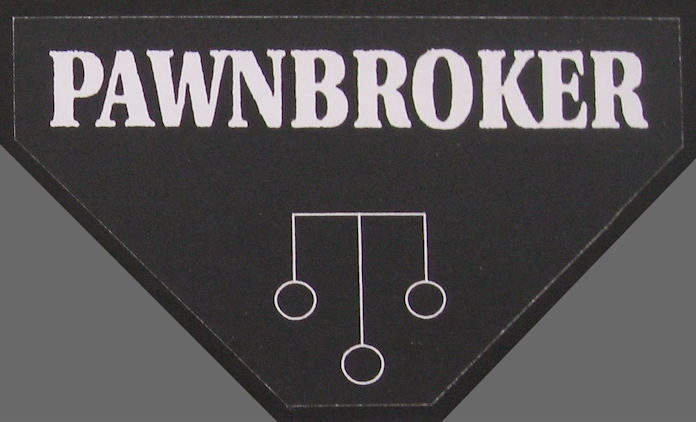The money lender game
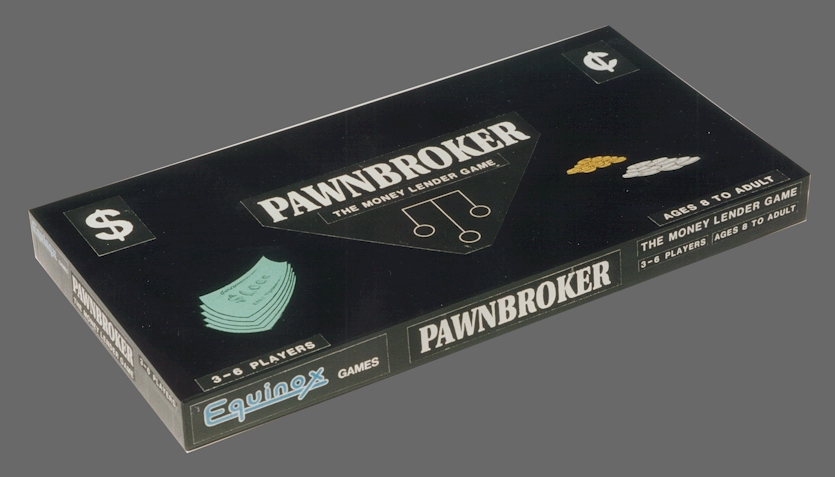
DESRIPTION OF THE GAME
Designed for three to six players PAWNBROKER is a fast, easy to learn “money“ game which is enjoyed most with a full compliment of players.
CONCEPT
PAWNBROKER
is a game representing the life of a pawnbroker. Each player adopts the roll of a pawnbroker advancing money and collecting interest on the goods (pawns) he or she receives. Each player builds up his/her own income while running the risk of being caught in possession of stolen goods received from a number of penny-ante criminals but more specifically the notorious gangster Al Capone. S/he may also benefit from or be deprived of the opportunities that arise when s/he disposes of goods by trade or auction while temporally adopting the roll of an auctioneer.
OBJECT OF THE GAME
To amass the greatest wealth amongst your pawnbroker opponents within a preset time agreed by all players.
Players accumulate their wealth by: -
Collecting interest on goods (pawns) received and held.
Profiting from goods sold, traded or auctioned.
Players reduce their wealth by: -
Being caught in possession of stolen goods.
Bad trading or bad bidding.
Note: - The lure of the bigger interest paid on the goods held for Al Capone may be deterred by the penalty imposed for being caught.
More risk is added with the auction element in the game.
Inventors Note:
This game idea is the third of four that I have developed tested and refined and the second money game. Probably helped by the lessons learnt pre-ceding, this game was easy to design and played well the very first time with few refinements needed. Making the auction element a roll-playing feature added to its enjoyment. When a player receives instructions to dispose of goods of a certain value by auction, that player will assume the role of an auctioneer. Not knowing the value of the goods on offer the other players will be encouraged and cajoled to bid blindly by the gavel wielding auctioneer, who alone knows their value. With the other players not knowing whether the goods up for auction are worth two hundred or up to twenty thousand dollars the bluffing skills of the auctioneer pitted against the bidders greed produce some very funny situations.
DESCRIPTION OF PLAYING PARTS
1. The Playing Board
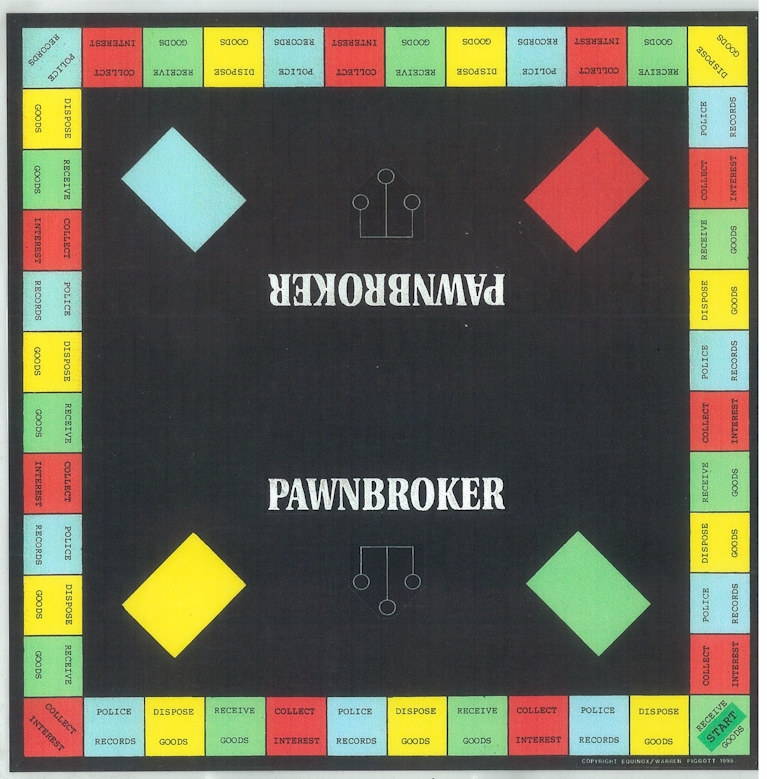
The board design features four types of playing spaces around the perimeter of the board. These playing spaces work in conjunction with the four types of playing cards: - Receive Goods, Dispose Goods, Police Records and Collect Interest.
The playing board has forty-four stepping squares around the perimeter. There is eleven of each of four different types.
These being: -
Receive Goods (green square spaces)
Dispose Goods (yellow square spaces)
Police Records (blue square spaces)
Collect Interest (red square spaces)
Corresponding card color positions are marked within the perimeter to place card stacks.
The green corner square space being the, receive goods
“START” position.

2. One 1 to 6 dice.
3. Six playing tokens.
4. Playing Cards: -
There are two hundred playing cards of four different types.
These being: -
Receive Goods (fifty green)
Dispose Goods (fifty yellow)
Police Records (fifty blue)
Collect Interest (fifty red)
5. One gavel and plate.
6. Play Money.

7. Rule Book.
USE OF PLAYING CARDS: -
RECEIVE GOODS cards are taken from the top of the (green) receive goods card stack, each time a player lands on a receive goods playing space.
Each card has the type of goods described at the top of the card.
Then their actual value.
Then the amount advanced to the borrower (paid back to the bank as the bank serves as if the borrower.
Then the interest amounts from ten to sixty percent that might be collected.
Finally (except in the case of “secured goods”) either the letter A, B, C, D, E, F (in brackets) or the name Al Capone will be at the bottom of the card.
Secured goods are guaranteed not stolen.
Examples of RECEIVE GOODS cards: -
 |
 |
|
When receiving goods a player pays the advance amount (half the value amount of the goods received) to the bank and places each one collected in front of him/her (face up) where they can be seen by the opposing players.
Each other type of card interacts with the receive goods cards.
If a player does not wish or cannot afford to buy the goods after having picked up a received goods card s/he does not reveal it but does declare a bank auction.
His or her opponents are invited to bid on it with the cardholder playing the auctioneer but ant monies going to the bank.
If no bidders the card is returned to the bottom of the receive goods card stack.
???? Inventors query on last sentence: - Maybe the cardholder can keep it for nothing. This could be an incentive for others to bid and a bit of gamesmanship for the cardholder.
DISPOSE GOODS cards are taken from the top of the (yellow) dispose goods card stack when responding to a dispose goods playing space.
A player will pick up one of three types of dispose goods card, “auction goods”, “trade goods” or “sell goods”.
In the case of "auction goods" the card will have: -
"Auction unredeemed pledge" with a Pawn value of (X)" amount or "Auction secured goods" Pawn value $2,000.
In the case of "trade goods" the card will have: -
"Trade Goods" E.g. Bone China.
In the case of "sell goods" the card will have: -
"Sell Goods" E.g. Art Works.
Trade goods and Sell goods are optional.
Examples of DISPOSE GOODS cards: -
When picking up an auction card a player must take care not to reveal it to his/her opponents, as s/he is more likely to benefit if the value of the goods to be auctioned can remain unknown to his/her opponents. Firstly s/he must look to see if any goods in his/her possession match the value to be auctioned. If there are none, the dispose goods card can be revealed and then returned to the bottom of the (yellow) dispose goods card stack. But if there is one or more goods of the value requested (apart from secured goods) then one of them must be auctioned. If the player is fortunate to have more than just one goods card, s/he may gather them up and secretly select the one to be auctioned. S/he then plays auctioneer using the gavel and encouraging his/her opponents to bid on the receive goods card that is placed face down with the "auction" card in the middle of the board. The highest bid before the third fall of the hammer receives the goods and the auction card is returned to the bottom of the dispose goods card stack. If in the event no one wishes to participate in the auction, the goods are kept.
When picking up a trade goods card from the dispose goods card stack a player has the option to trade (swap) goods of the same type E.g. Silverware with any other player with silverware of a higher value.
When picking up a sell goods card from the dispose goods stack a player has the option to sell goods of the type described on the card back to the bank for the pawn value (twice as much as what was originally paid). Cashing a card can only be done this way.
Note: - As a pawnbroker players must avoid bankruptcy and keep a cash flow. If a player runs out of cash s/he is deemed bankrupt and out of the game. At the games conclusion only the cash in each player's possession is tallied not the values of goods.
POLICE RECORDS cards are taken from the top of the (blue) police records card stack each time a player lands on a police records playing space.
There are seven types of police records card. Six identify a fingerprint to a letter that represent six different (penny ante) criminals and the seventh the thumbprint and name of the notorious gangster Al Capone.
Examples of POLICE RECORDS cards: -
 |
 |
|
When picking up a police records card a player looks to his or her acquired "receive goods" cards and if one or more have the matching letter A, B, C, D, E, F or the name Al Capone s/he forfeits it or them and returns the goods card/s back to the bottom of the receive goods card stack as they are deemed as stolen goods. The player must now the die to determine the size of the fine imposed for dealing in stolen goods.
For associating with A, B, C, D, E and F:
E.g. 1 = one hundred dollars
6 = six hundred dollars
Having any association with Al Capone is regarded as far more serious and the fine imposed far more severe: -
E.g. 1 = one thousand dollars
6 = six thousand dollars
COLLECT INTEREST cards are picked up from the top of the (red) collect interest card stack when a player lands on a collect interest square.
There are seven types of collect interest card: - 10%, 20%, 30%, 40%, 50%, 60% and DEFAULT.
Examples of COLLECT INTEREST cards: -
 |
 |
|
When picking up a collect interest card the amount shown (other than default) is the amount that can be collected (from the bank) for each individual receive goods card the player might have in his/her possession. That is to say. Guided by the interest scale on each separate receive goods card the player can add the individual amounts together for the total amount to be collected from the bank. Once used the collect interest card is returned to the bottom of the collect interest card stack.
Note: - DISPOSE GOODS, POLICE RECORDS, COLLECT INTEREST cards need only be picked up if the player concerned has any RECEIVE GOODS cards.
TO PLAY
Firstly a banker is chosen and that player distributes four notes of each value of PAWNBROKER™ money to each player while the other players shuffle the playing cards and place them on their individual card stack positions. I.e. Receive Goods (green). All players now select a playing token and place them on the receive goods /
"START" position on the board.
Each player now throws the dice. The highest throw will start the game and play will continue clockwise.
Before starting each player (in the selected order) picks up one "receive goods" card from the top of the receive goods card stack and pays to the bank the "Advance" amount shown on the face of the card.
The first player now throws the dice and moves responding to the playing spaces and the cards they relate to.
Play continues until a prearranged time is reached and each player has his or her final turn.
Any goods still held are in pawn and belong to the borrower (the bank) so their value is not included in the tallying of wealth.
Once the moneys have been counted the winner have been counted the winner makes the coffee.
